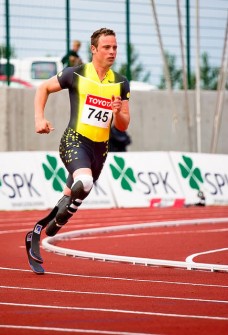
Photograph of Oscar Pistorius at Landsmót ungmennafélags Íslands 2007 by Elvar Freyr
And then, within days of the games, South African athletic authorities decided to make an exception and select Pistorius for the 400 metres and 400 metres relay.
He will also compete in South Africa’s London 2012 Paralympics team, and will defend his 100m, 200m and 400-metres Paralympic titles.
The Olympic decision is certainly a victory of sorts, but for what and whom?
How did we get here?
Pistorius has spent most of this year travelling the globe trying to register a 400-metre time fast enough to qualify for London.
After a series of not-so-near misses, his final hope was last month’s African Senior Championships in Porto Novo, Benin (see video below). Again he missed, this time by a relatively narrow 0.22 of a second.
The move by the South African Olympic committee to overturn its earlier decision means Pistorius will become the first amputee to compete against “able-bodied” sprinters at the Olympic Games. By any measure, it is landmark moment in the history of modern sport.
Who is Oscar Pistorius?
Pistorius was born without fibulas (calf bones) and learned to walk on prosthetic legs. After a remarkably sport-filled childhood, he became the world’s dominant Paralympian male sprinter and by the mid-2000s was looking for new challenges.
His application to be allowed to compete at the 2008 Beijing able-bodied Olympics was initially turned down by world athletics’ governing body, the IAAF, on the basis of a single scientific study.
The study found that Pistorius’ carbon-fibre prosthetic legs – or “Cheetahs” – gave him an unfair advantage over “intact-limb” runners.
The IAAF’s haste to resolve the issue, not to mention the small amount of data it relied on to arrive at its decision, probably made what happened next inevitable.
With legal and scientific experts on board, and armed with their own data refuting the unfair advantage conclusion of the IAAF’s study, Team Pistorius took their case to the Court of Arbitration for Sport (CAS), sport’s equivalent of the Privy Council.
CAS duly overturned the IAAF’s decision, finding that the original study had not conclusively proved unfair advantage.
Although greeted with disbelief in some circles, the decision was not all that surprising. As anyone who studies it will tell you, human motion is an extraordinarily complex and subtle mechanical and physiological phenomenon.
No matter how good the IAAF’s original study was, it was never going to provide the last word on the matter.
At this point, things get murky and, among those who’ve taken an interest in the affair, impartiality is rare.
Cans of worms
At the time of the CAS verdict in 2008, I had a small involvement in the sporting media and it was immediately clear that many thought the decision a great day for the human rights of disabled people and step forward for sport.
What most people didn’t know at the time was that Pistorius and his entourage are a formidable entity and enjoy substantial financial backing. Their publicity machine has been keen to play up the human rights angle and much less forthcoming about the involvement of Pistorius’ many sponsors and the commercial interests of the Cheetahs’ makers.
More recently, online discussion among scientists reveals a couple of interesting things. First, some point out that a wide range of relevant variables – such as the comparative elasticity of human tissue compared with carbon-fibre, the length of the prosthetic limb and the nature of the articulation between the prosthetic and the body – were not even considered in the CAS decision.
In short, some scientists believe that Pistorius’ carbon-fibre blades give him a clear and unarguable advantage over non-disabled runners, which brings us to a second worrying development.
There are those who say their attempts to communicate scientific concerns about the CAS decision to the media have been ignored or misunderstood because it spoils the “feelgood” story Pistorius has provided. Worse, I have read claims that pressure from disability advocates has convinced some experts to simply say nothing.
In one sense, the controversy surrounding Pistorius is misplaced: CAS made it clear that their ruling only applied to the use of one particular type of blade; the kind that Pistorius uses and no other.
In reality, there are many more advanced forms of the device in the pipeline and the issue will need to be tackled again. And this is the point that most commentators have missed.
Pistorius has managed to garner support precisely and only because he has been close, but not too close, to the performance of the best non-disabled athletes. If he had been much slower, the whole business would have seemed slightly sad and disappeared quickly.
But if Pistorius had managed to beat his non-disabled peers – and at one stage his rate of improvement was so fast this did not seem impossible – spectators would have been left with the extremely confusing task of deciding what to make of it all. Would it have been a sporting result that made sense to anyone?
Sport, but not as we know it
On the surface, the Pistorius case looks like a fight over science: does he have an advantage or not?
In reality it is something quite different. The prosthetically-enhanced human who can easily outrun their “normal” competitors is coming. He or she is just a matter of time.
The question for people who care about sport and want to preserve the enjoyment we get from it is how far we allow the technologisation and the commercialisation of sport – and despite all the emotion, Pistorius represents both – to go.
The risk is that one day, regardless of what the scientists say, we will be presented with sporting contests that don’t look or feel like sport any more. At that point, the golden goose will be dead.
Pistorius’ ultimately successful struggle to qualify for London has, perhaps not surprisingly, garnered much less media attention than the original decision to let him try.
What this calm before the inevitable storm conceals is that we have entered the final stage of a cold war that began in the 1960s between the people who make money out of sport and the people who watch it.
This war revolves around finding answers to a single organising question that sport’s entrepreneurs ask themselves every day: how far can the paying public’s understanding of what sport is be stretched, mutated and exploited for commercial advantage without undermining their emotional commitment to it?
In this sense, the struggle is between those who like sport the way it is and those for whom stasis is death.
There can only be one winner. And so one day, although we won’t know why, we will wake up and know that we don’t care any more.
Enjoy it while it lasts, I say.
Written by Michael Gard, Southern Cross University
Michael Gard does not work for, consult to, own shares in or receive funding from any company or organisation that would benefit from this article, and has no relevant affiliations.
![]()




